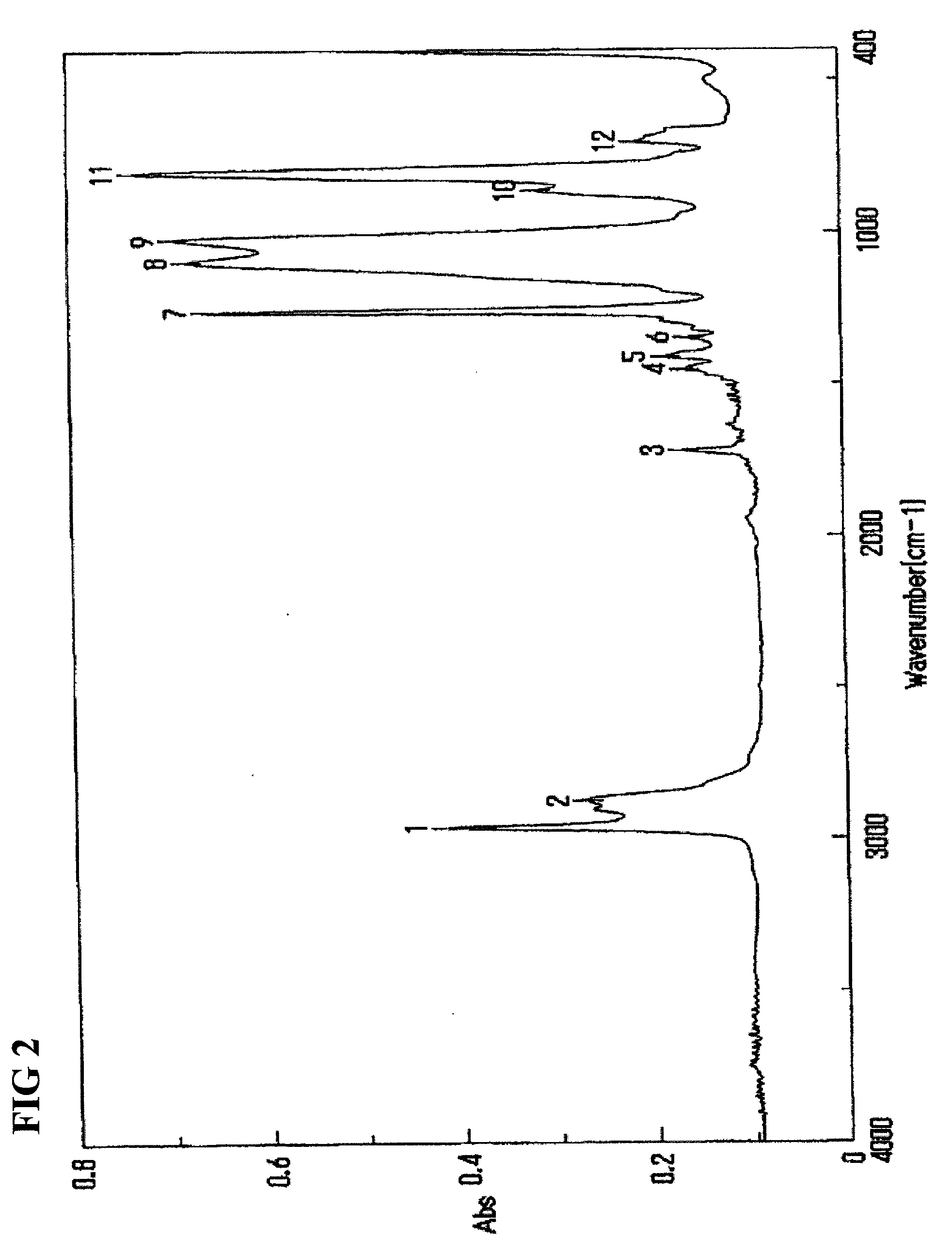Hydrophilic Polysiloxane Macromonomer, and Production and Use of the same
a technology of hydrophilic polysiloxane and macromonomers, which is applied in the field of hydrophilic polysiloxane macromonomers, methods of production thereof, and ophthalmic lenses, can solve the problems of difficult to produce transparent contact lenses, difficult to use polysiloxane as a raw material for ophthalmic lenses with high oxygen permeability and high hydrophilic properties, and achieve high oxygen permeability, high hydrophilic properties, and good compatibil
- Summary
- Abstract
- Description
- Claims
- Application Information
AI Technical Summary
Benefits of technology
Problems solved by technology
Method used
Image
Examples
example 1
[0055]Dissolution of 9.7 g of 1,3-bis(3-methacryloxypropyl)-1,1,3,3-tetramethyldisiloxane (TSL9706, Momentive), 139 g of octamethylcyclotetrasiloxane (LS8620, Shin-Etsu Chemical), and 7.5 g of 1,3,5,7-tetramethylcyclotetrasiloxane (LS8600, Shin-Etsu Chemical) in 170 g of chloroform was performed, trifluoromethanesulfonic acid (Wako Pure Chemical Industries) was further added, and this mixture was stirred at 35° C. After 24 hours, 170 g of a 0.5% aqueous sodium hydrogen carbonate solution was added to stop the reaction. After having washed the reaction liquid with 170 g of pure water five times, the reaction solvent was distilled out under reduced pressure to obtain 140 g of a residue. After having washed the residue with 28 g of acetone and 140 g of methanol four times, the cleaning liquid was distilled out under reduced pressure to obtain 100 g of an intermediate A.
example 2
[0056]Dissolution of 15 g of the intermediate A and 10 g of methoxy polyethylene glycol allyl ether having a molecular weight of about 400 (Uniox PKA5007, NOF Corporation) in 30 g of Isopropanol was performed, and 0.015 g of potassium acetate and 0.003 g of chloroplatinic acid were further added to the solution, and this mixture was stirred for 2 hours at 40° C. The reaction solvent was distilled out under reduced pressure, followed by washing the residue with 26 g of acetone and 6.5 g of pure water. After having repeated the same washing operation for six times, the cleaning liquid was distilled out under reduced pressure to obtain 13 g of a hydrophilic polysiloxane macromonomer A of interest.
[0057]The structural formula of a synthesized hydrophilic polysiloxane macromonomer is presented in general formula (12), wherein the configuration of siloxane units includes a random configuration. In general formula (12), a hydrophilic polysiloxane macromonomer represented by general formula...
example 3
[0060]Synthesis and washing were carried out by the same method as in Example 2, except that methoxy polyethylene glycol allyl ether (Uniox PKA5007) used in Example 2 was substituted with 10 g of polyethylene glycol allyl ether having a molecular weight of about 400 (PKA5002, NOF Corporation), to obtain 13 g of a hydrophilic polysiloxane macromonomer B of interest.
[0061]The results of analysis of 1H-NMR exhibit a=about 90, b=about 5, n=about 7, m=0, and R2 representing hydrogen in general formula (1).
PUM
| Property | Measurement | Unit |
|---|---|---|
| Water content | aaaaa | aaaaa |
| Water content | aaaaa | aaaaa |
| Water content | aaaaa | aaaaa |
Abstract
Description
Claims
Application Information
 Login to View More
Login to View More - R&D
- Intellectual Property
- Life Sciences
- Materials
- Tech Scout
- Unparalleled Data Quality
- Higher Quality Content
- 60% Fewer Hallucinations
Browse by: Latest US Patents, China's latest patents, Technical Efficacy Thesaurus, Application Domain, Technology Topic, Popular Technical Reports.
© 2025 PatSnap. All rights reserved.Legal|Privacy policy|Modern Slavery Act Transparency Statement|Sitemap|About US| Contact US: help@patsnap.com



